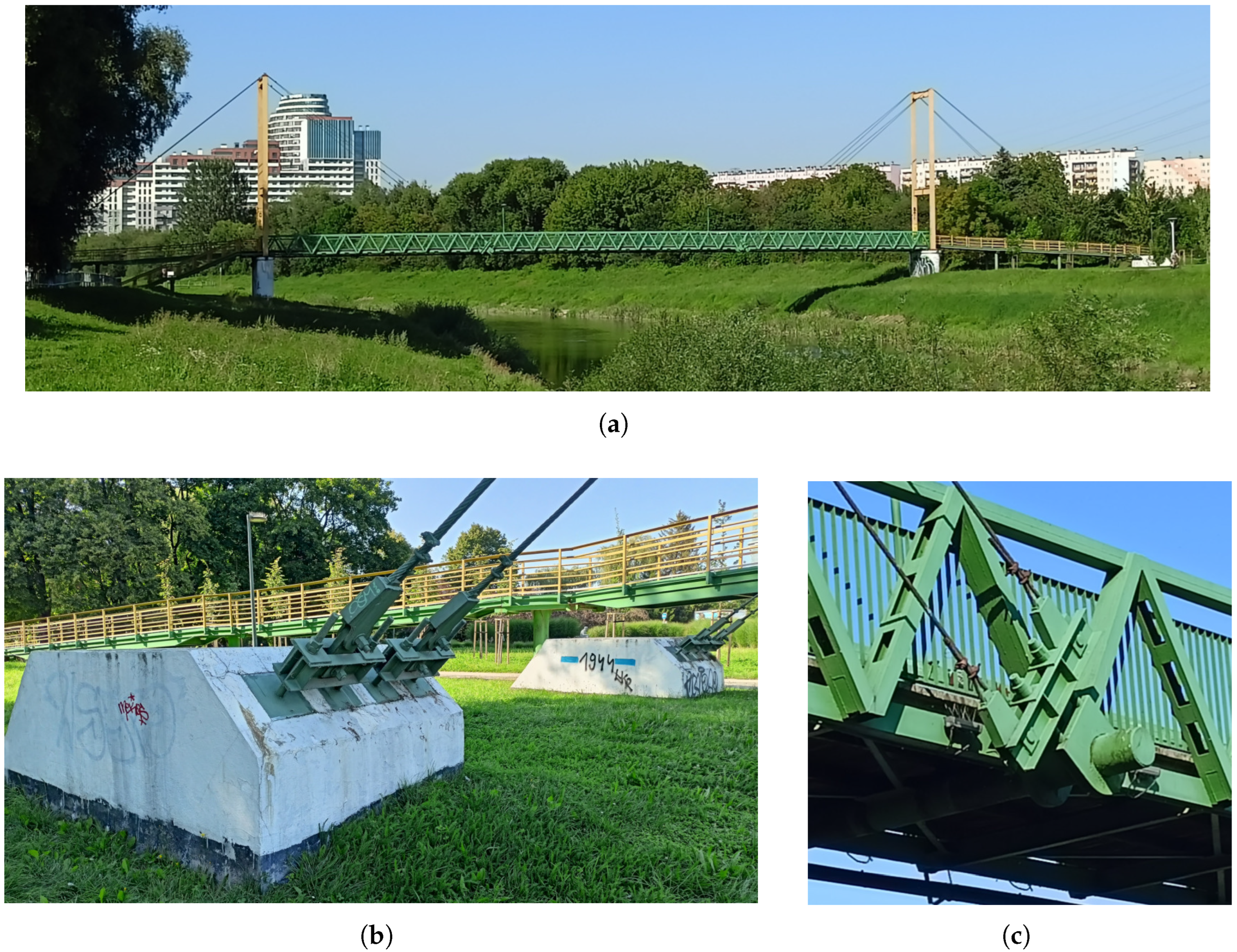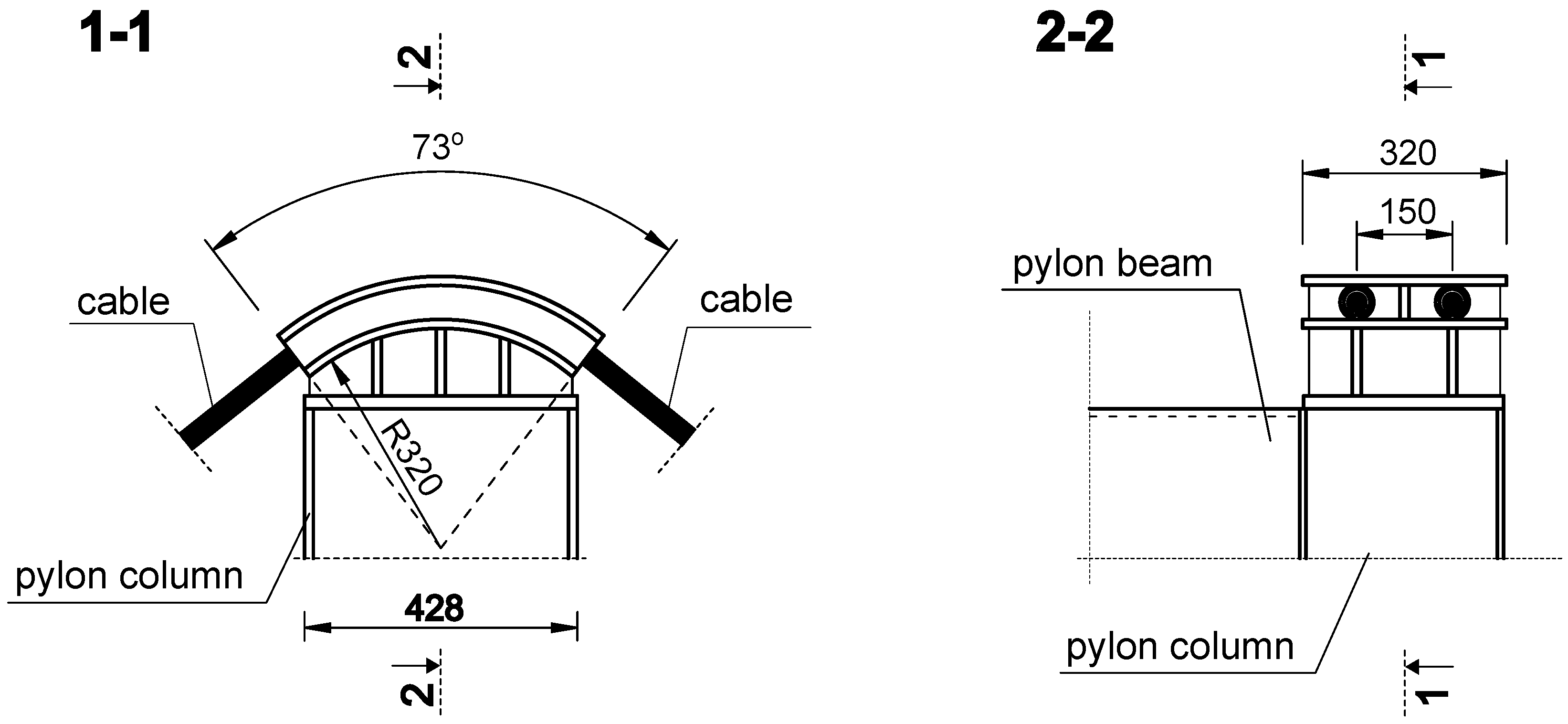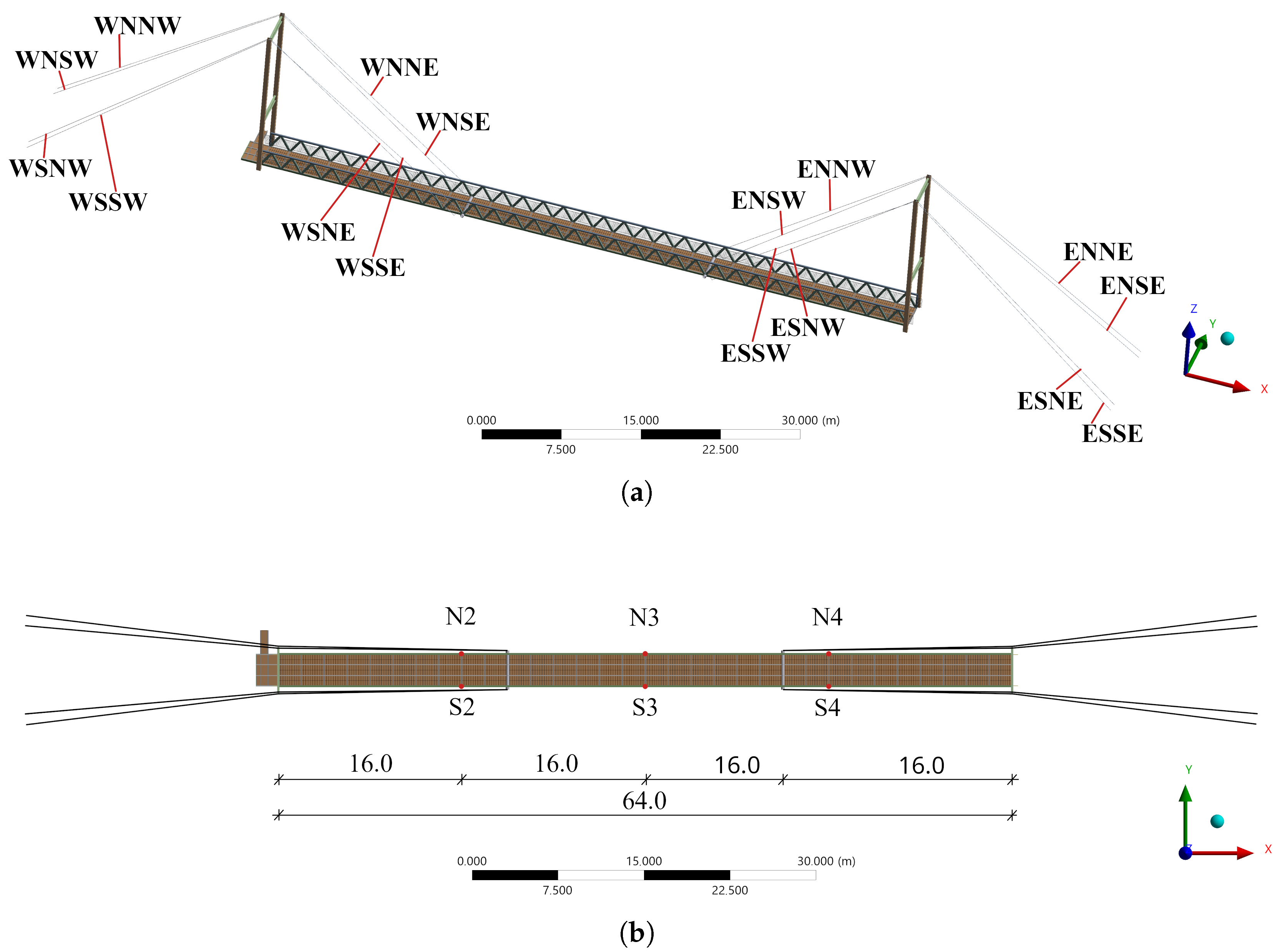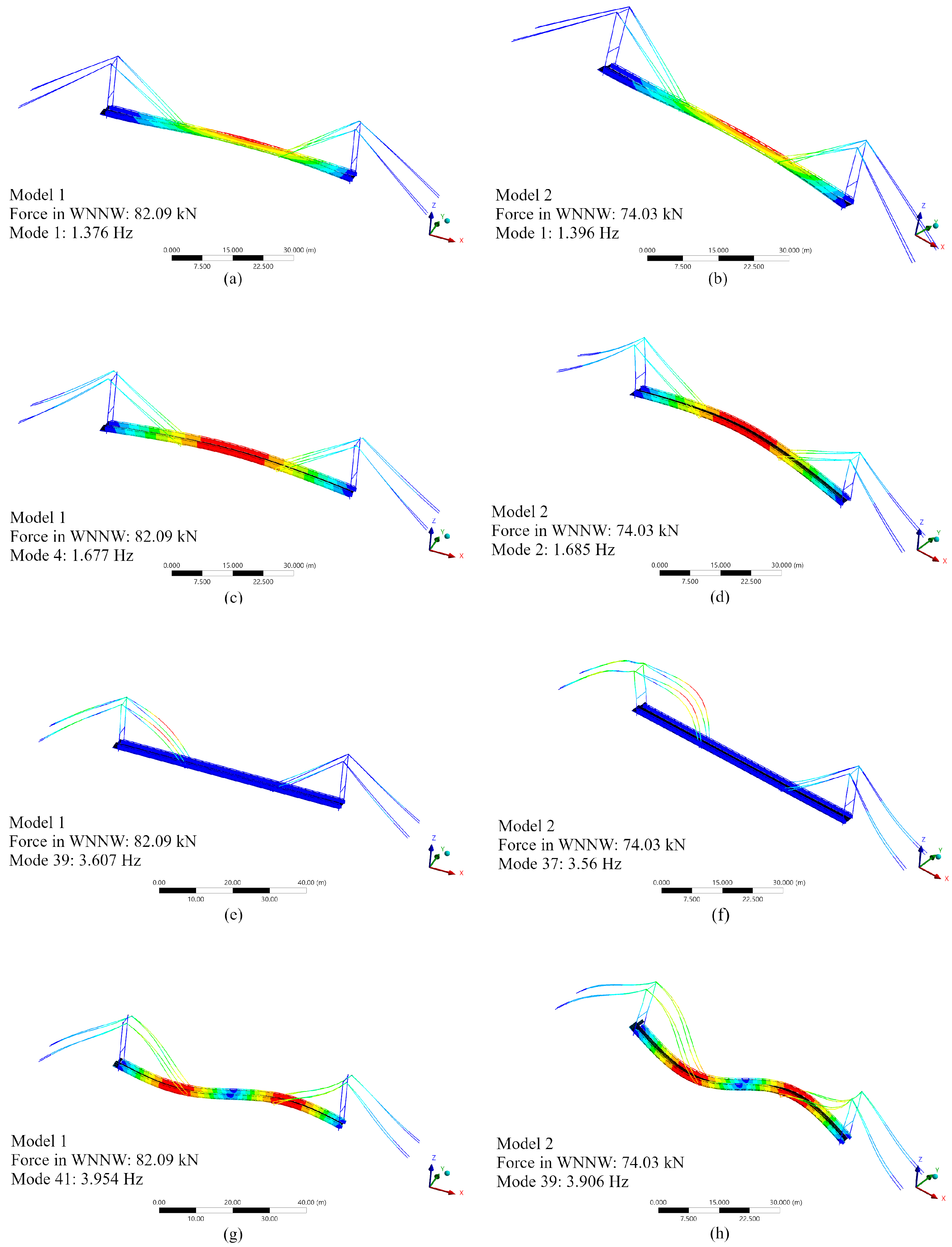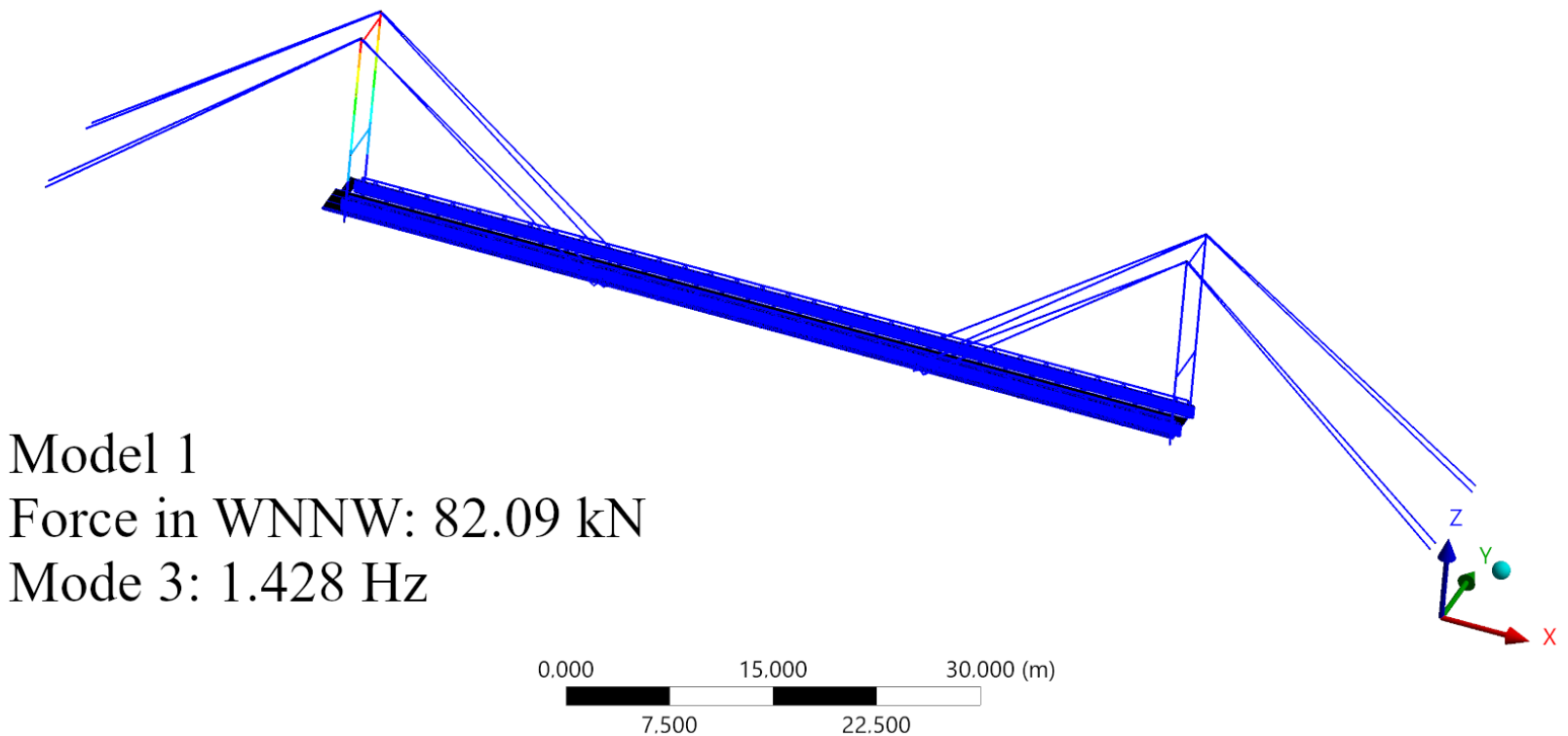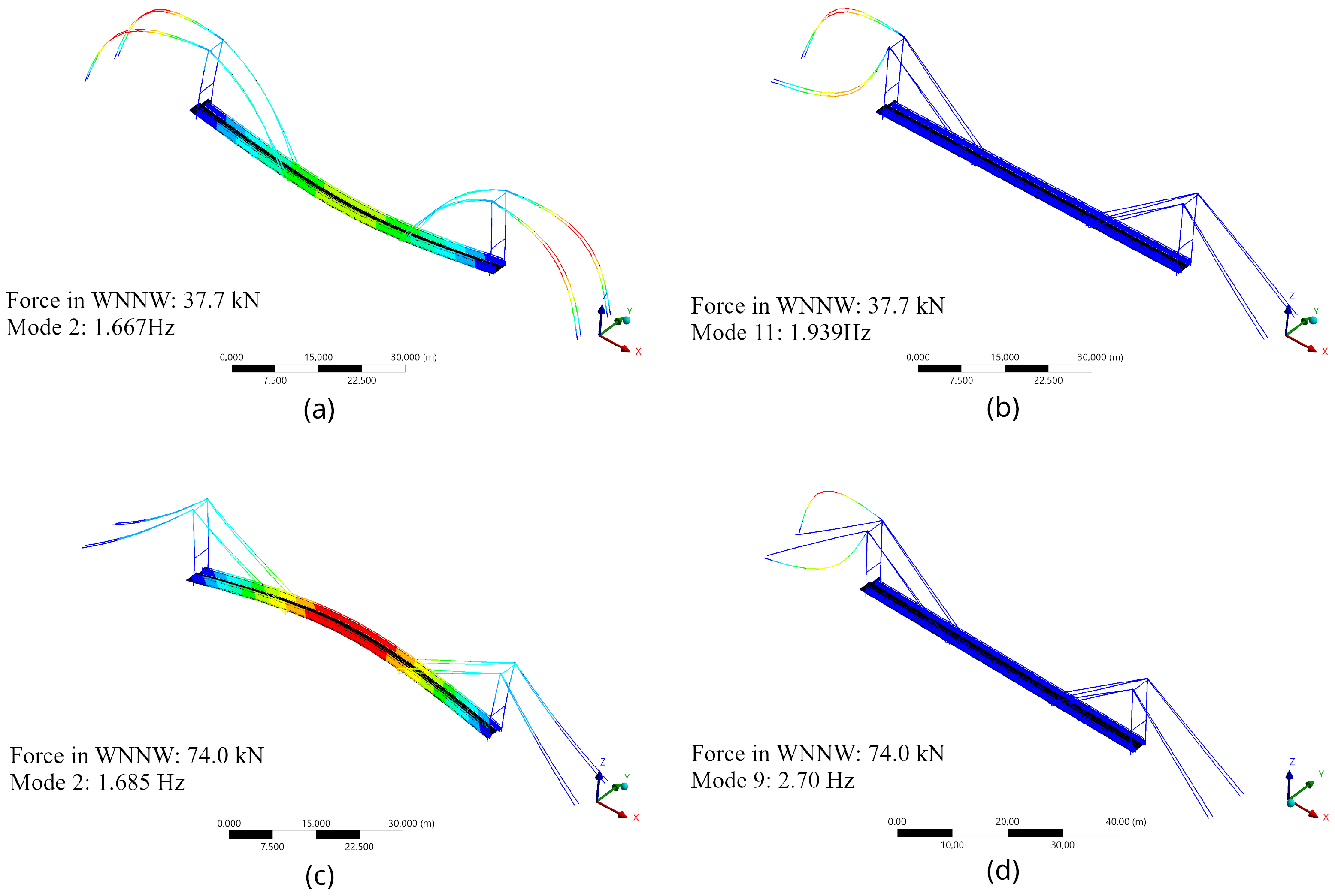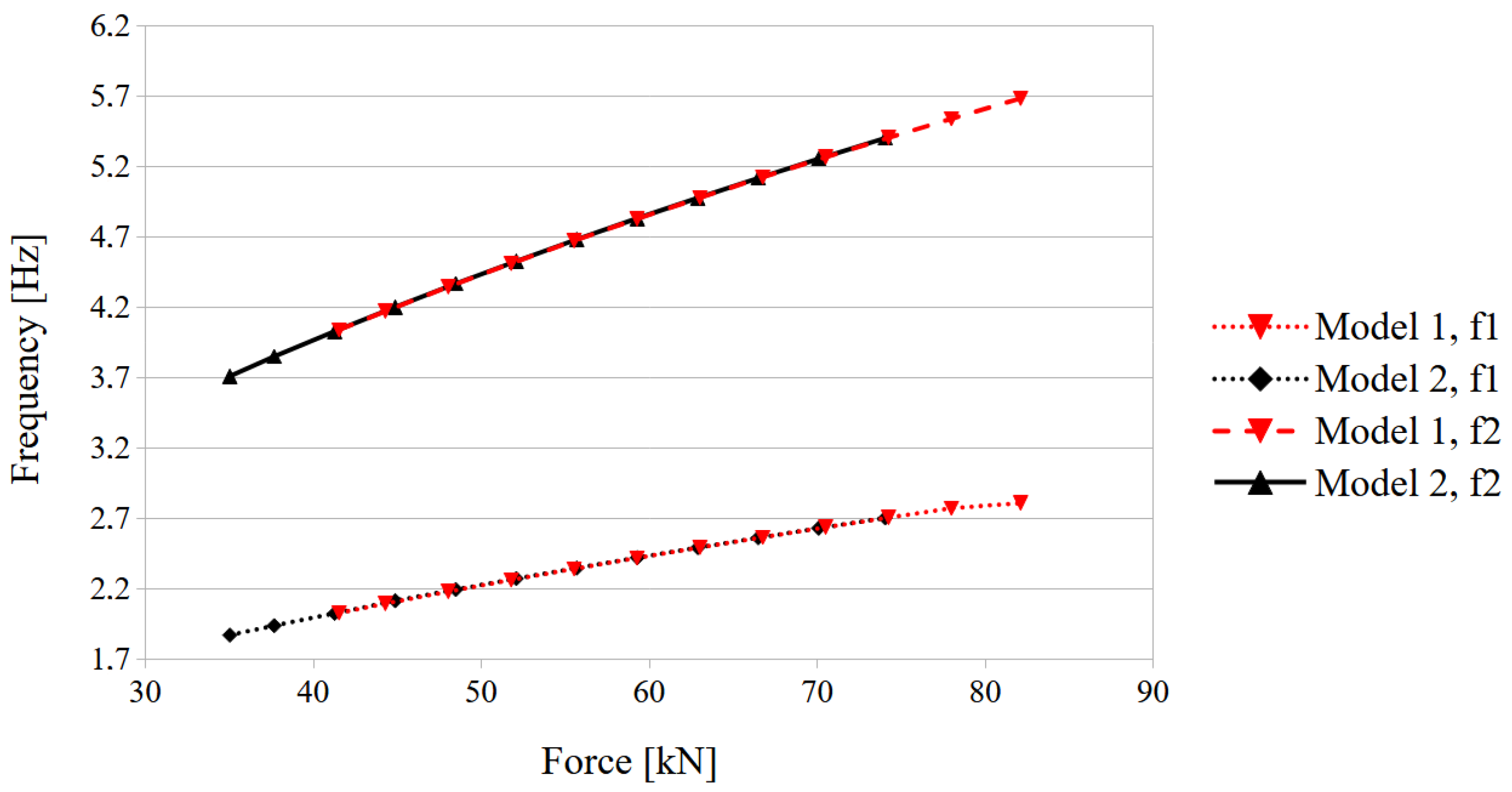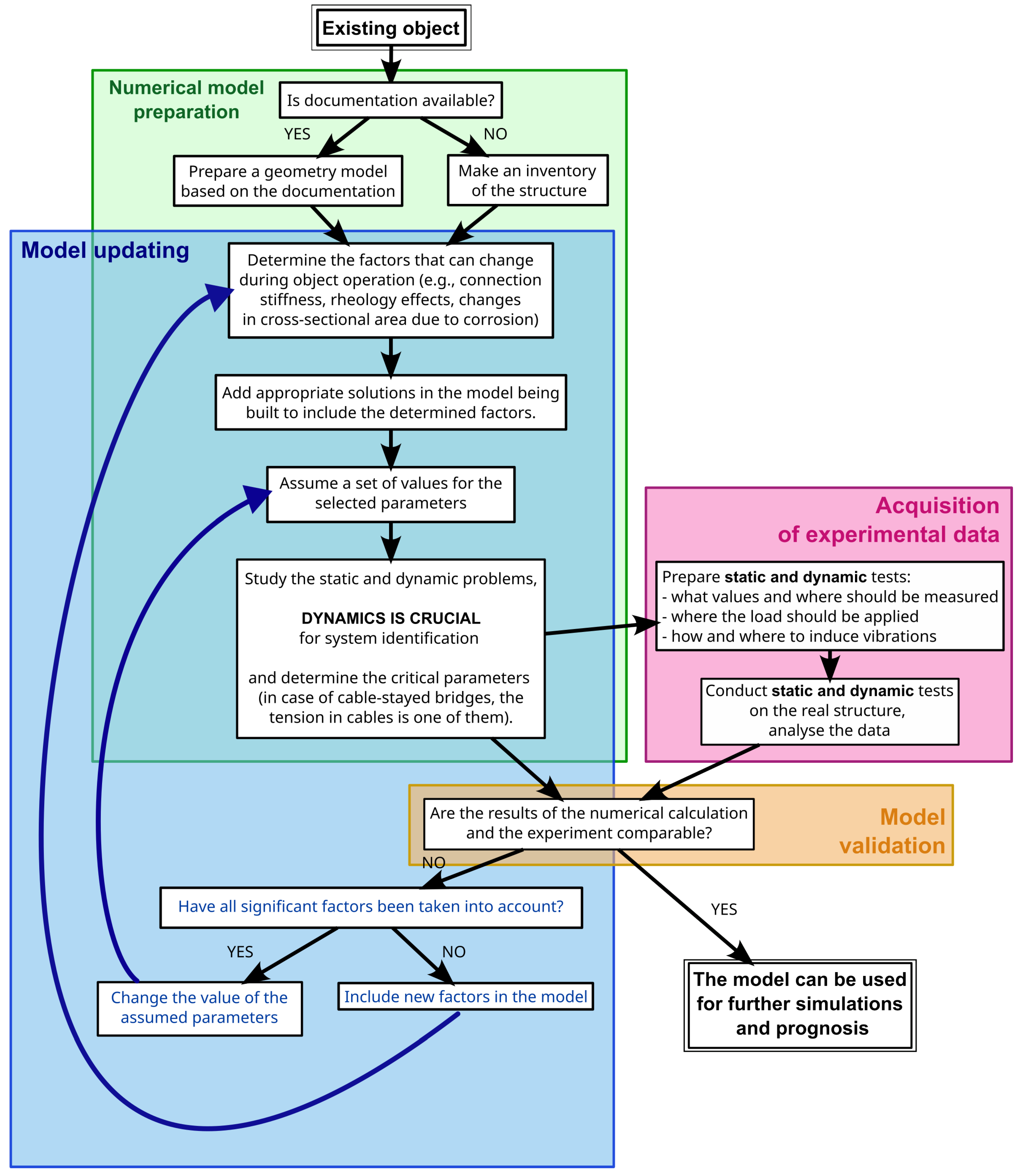1. Introduction
The maintenance of existing civil engineering structures in good condition, especially important ones like bridges, is a necessity from the point of view of safe usage. Despite this awareness, ensuring safety is difficult due to the cost of maintenance, inspections, and repairs. As shown in [
1] many structures should be withdrawn from use and dismantled. In practice, however, these structures are still in use, accepting the risk of failure or disaster, which is reported by the media from time to time.
The condition monitoring of the structure is still a complicated and expensive process. It requires the selection of suitable measurement techniques, which can operate on the structure under normal exploitation (non-destructive testing, NDT). In the case of permanent attachment of sensors, continuous data recording and evaluation, the structural health monitoring (SHM) systems are considered. Due to the high costs of SHM systems implementation, only the most important, large, and complex structures are equipped with them [
2,
3]. One of the phenomenon widely used in SHM are vibrations [
2,
4,
5,
6,
7,
8], especially in low frequencies. Vibration-based global monitoring techniques were described by Yon and Min in [
9]. Typical sensors used for these measurements are accelerometers. They can be connected to the recording unit with cables or work wirelessly. As an alternative to dedicated laboratory equipment, smartphones are used more and more often [
10].
Three main approaches for damage detection based on vibration analysis are used, namely studying changes in the following: (1) natural frequencies [
11,
12,
13], (2) natural frequencies and forms [
14,
15], and (3) the shape of the frequency response function (FRF) [
16]. Despite many researchers showing that changes in natural frequencies of vibrating structures are correlated with damage [
14,
16], they are also dependent on environmental factors (e.g., temperature) [
11,
12,
17], and in the case of local, small-sized damage, insensitive [
15]. Rudzik et al. showed that in the case of local damages, global natural frequencies did not vary significantly; instead, new local modal shapes appeared. In this context, the location of sensors is crucial. The optimization of data that can be obtained in itself is a separate scientific problem [
18,
19,
20,
21]. Tan and Zhang [
19] formulated the problem, possible evaluation criteria, and compiled the accessible methods. Regardless of the optimization method (genetic algorithms, modal strain energy, particle swarm optimization, etc.), the process needs the numerical model of the structure.
As time passes, materials degrade and change their properties, which influences the behavior of structures [
22]. Many objects were built in the past centuries or decades [
23], and lack numerical models that can be used to predict their behavior under today’s conditions [
24]. The technical documentation of some of them is also lost [
25]. In such cases, maintenance decisions first require additional activities related to system identification [
4].
Footbridges are a special type of structure. Among the static systems used in footbridges, the following can be distinguished: beam [
26,
27], arch [
4], cable-stayed [
26], or suspension structures [
28]. Many of them are long-span. Taking into account the main construction material, footbridges are made from steel [
27], wood [
29], reinforced concrete [
30], as well as Glass Fiber Reinforced Polymers (GFRPs) [
22], and their combinations [
31]. They are mainly the lightweight and slender objects, for which dynamic phenomena cannot be ignored.
In addition to loads caused by gravity or environmental conditions (temperature [
32], wind [
28] ), footbridges must carry loads generated by their users. Dynamic loads generated by pedestrians or runners are typical for footbridges [
32,
33] and have to be taken into account in the design and assessment process of these facilities. Humans interact with the vibrating structure, both exciting the vibrations and reacting to them [
34,
35,
36]. Their mass changes the properties of footbridges, making them part of the whole system rather than only an external load [
28,
37,
38].
In recent years, research on human-induced vibrations and human–structure interaction has become both popular and necessary. Excessive vibrations not only cause user discomfort but can also lead to potential structural fatigue and damage. Bedon et al. [
39] used the spring-mass-damper to model the pedestrian-induced loading. The results obtained using this model match the in situ tests on cable-stayed steel–concrete composite bridge. Vertical human-induced vibration was modeled by Li et al. [
30] based on the statistical data collected during observation of pedestrian movement on the suspension footbridge. The parameters used in the model were as follows: the step frequency, step length, and walking velocity. The vertical walking force induced by a single pedestrian was the subject of study shown in [
40]. One of the conclusions from this paper is the necessity of accounting for the variability in human walking for a proper assessment of the structure’s vibration response. Chen et al. [
41] studied the mechanism of lateral pedestrian–footbridge interaction. They pointed out that the response amplitude depends on the ratio between pedestrian mass and footbridge mass and varies with different pedestrian walking frequencies. Other examinations of the lateral vibration of slender footbridges are shown in [
42]. The authors proposed a method that, based on a frequency domain approach, allows for the estimation of the lateral response of slender footbridges under critical crowded density. This is the loading case in which the auto-induced component of the load must be included. The description of the crowd’s influence on the footbridges can also be found in [
43]. It is worth noting that people in crowds behave differently than individuals [
44], especially when their movement is restricted.
Many existing pedestrian bridges do not meet serviceability criteria under dynamic pedestrian loads [
45]. Pedestrian-induced footbridge vibration, as shown in [
46], leads to feelings of discomfort and insecurity. Seeing inconsistencies in serviceability assessments in traditional evaluation methods, researchers try to find objective ones [
47].
The limitation of human-induced vibration can and should be addressed at the design stage by properly shaping the structure and adjusting its stiffness and/or mass. An example of such an approach, where two variants of fiber-reinforced polymer cable-stayed pedestrian bridges were discussed based on data from numerical simulation, is shown in [
48]. The problem of resonance induced by human walking in footbridges with deck slabs made with reinforced concrete and GFRP was discussed in [
26]. Shifting the lowest natural frequency of the object above 5 Hz (which is the limited value for the footbridges) in the case of GFRP slab was observed. However, it did not guarantee resonance avoiding.
In the case of exceeding the permissible vibrations in existing structures under operation, some modifications are still possible. In [
27] it is shown that the addition of non-structural elements, e.g., vinyl flooring, can increase damping ratios, thus reducing the vibration. The lack of usage comfort due to vibrations can be reduced with dampers, e.g., tuned mass damper (TMD) [
49]. However, all structure modifications should be preceded by thorough analysis and numerical simulations.
The most popular method for numerical modeling of pedestrian bridges is the Finite Element Method (FEM). Today’s hardware and software enable building the numerical models for static, dynamic, and transient analysis of even complicated structures. The FEM models were used in [
31] for both the global analysis of timber–steel footbridge and its separated components. The authors pointed out that adopted joint stiffness parameters are crucial in dynamic behavior analysis.
Numerical models are simplifications of reality and often use the ideal geometry, boundary conditions, and material properties. In reality, all properties can vary, and a combination of these variations affects discrepancies between models and structural response. Each model has to be validated. In the case of footbridges, the validation is made based on data obtained in static and dynamic tests [
4]. Different measurement techniques are used for dynamic tests, as described in [
50]. The authors showed their advantages and disadvantages and the types of data that can be obtained. The simplest and, at the same time, the most popular technique is the acceleration measurement. The recorded signals can be analyzed in the time and frequency domains to obtain parameters such as natural frequencies, damping ratios, and, with appropriate measurement configuration, natural forms.
Examples of model validations for different footbridges based on data from dynamic measurements can be found in [
24,
26,
29,
51,
52]. Modeling of the structure is a difficult process; it often requires finding the parameters crucial for the structure’s behavior and their updating [
53,
54]. However, a model with satisfactory agreement with reality can be used for predicting human–structure interaction [
22], prediction of structure response in the case of extraordinary loading [
32], and structure diagnostics [
45,
53,
55].
Discrepancies between the model and reality, especially in the case of old structures, may indicate deterioration of materials or connections. Examples of short- and long-term monitoring of footbridges can be found in [
56,
57], and the SHM systems used FEM models in [
4,
50]. It has to be noted that the process of going from measurements and FEM models to evaluating the structural condition status is long. Many times it requires the application of statistical tools [
11] or machine learning (e.g., shallow or deep neural network [
12,
17]).
This article aims to perform system identification of a nearly 30-year-old steel footbridge over the Wisłok River in Rzeszów (Poland). The design documentation of the bridge has been lost, and since its construction, the footbridge has been subject to renovations. The structure is highly susceptible to pedestrian traffic, and before any actions are taken to improve the comfort of use, it is necessary to create and validate a numerical model and assess the force distribution in the structure. Two main purposes of the article have been formulated:
Development of a numerical model of an old footbridge, whose components have been degraded due to long-term use. Changes, compared to the ‘original’, focused on elongation of the cables due to rheology and a decrease in their tension.
Demonstrate the challenges in modeling and validating this type of bridge, especially in the lack of complete documentation.
The excessive vibrations of the structure are not just a matter of comfort of use; they can be both a result of existing damage or lead to faster destruction of the structure due to fatigue. The article presents the initial stage of the way to develop a footbridge monitoring system for old cable-stayed structures.
4. Discussion
Comparison of the data in
Table 7 shows that frequencies measured on the real structure were much lower than those calculated for pre-tensioned models that matched the assumed grade line. While the pre-tension in cables was reduced (Model 1A or Model 2A), the natural frequencies in numerical and experimental data reached greater compliance. However, the grade line location then deviated significantly from the assumption based on archival documentation (
Table 3).
Determining whether Model 1 or Model 2 assumptions (allowing or restricting cable and suspension movement) are correct remains ambiguous. In Models 1 and 1A the ratio of the frequencies for inner cables (near the footbridge axis) and outer ones was approximately . In the case of Models 2 and 2A, only the frequencies for the cables between pylons varied, by about 5–7%. These tendencies were not observed in experimental data, suggesting that cable forces were lower than expected and unevenly distributed. This suggests that individual cables may age differently, which is possible. Connection conditions (e.g., sleeves) may also differ between cables.
The influence of force increment on the first two natural frequencies in the case of cable WNNW and the model with and without end releases is shown in
Figure 10. Forces in cables result from imposed temperature changes used to simulate pre-tension and the adopted static scheme (see
Section 2.2 and
Table 1). In a certain range of axial force in the cable, both models produced the same natural frequency value. This may explain why the precise identification of the proper numerical model is so difficult. It is still important to remember that these relations are prepared for a uniform increase in force in all cables. This issue requires further research, especially taking into account the conclusions from the previous paragraph.
The attempt to establish a valid numerical model for the analyzed pedestrian bridge can be summarized as follows:
The static test did not provide sufficient information to determine the appropriate model (see
Table 3; identical vertical displacements were obtained for different boundary conditions and pre-tension). Missing information must be obtained from dynamic parameters.
Determining the condition (allowed movement) of connections between cables, pylons, and the span requires simultaneous vibration measurements of all these elements.
If force changes are proportional across all cables, the axial force magnitude (within the analyzed range) has negligible impact on the main-span modal shapes and frequencies, but it does affect global modal shapes. Therefore, global modal similarity should also be assessed when evaluating system condition alongside main-span dynamics.
Cable axial forces strongly influence cable natural frequencies. This study considered only uniform increases in cable tension; future work will assess the effects of uneven force changes on the bridge’s modal forms.
Precise determination of axial cable forces from dynamic parameters requires simultaneous measurements on many (ideally all) cables and identification of their mode shapes.
In the case of the measurement on a single cable, some of the identified natural frequencies for cables can be mistaken for the global natural frequencies of the pedestrian bridge.
The results of dynamic measurement of cables suggest that the real structure works like in Model 2—the rigidity of the connection is higher than in Model 1, and as a consequence, the axial force distribution is uniform. Axial forces in internal and external cables (e.g., WNNW and WNSW) were nearly equal.
Cable force magnitudes inferred from experimental free vibration frequencies were much lower than those obtained by matching the numerical model to archival grade-line displacements. Possible reasons include the following:
The unknown construction technology of the facility due to the lack of documentation; in particular, the value of the possible execution lift and the tension force applied to the cables. In the analyzed model, the execution lift was not applied;
The exact parameters of cables are unknown; the model was prepared based on assumptions set in archival technical expertise;
Renovations and component replacements may have altered current structural behavior;
Aging mechanisms over nearly 30 years (e.g., rheological effects) likely reduced cable forces;
Flood events submerged anchor blocks and could have modified anchorage conditions, thereby affecting cable forces.
Further examinations are planned (e.g., simultaneous vibration measurements of cables, pylons, and main span), and a search for archival documentation has been commissioned.
In the area of model verification and validation, the application of multicriteria optimization techniques is planned to tune the individual tension in each cable to the data obtained from the dynamic experiment, as well as including eventual initial elevation, changes in the mass (losses caused by corrosion, excesses related to a thick layer of paint), and degradation of the supports’ elements.
Dynamic measurement of the analyzed footbridge should be preceded by preliminary computer modal analyses to obtain, from numerical calculation, points at which the first and second modes of the bridge have nodes (no vibrations) or the largest displacements. Based on this, the first point should be determined where the second mode has nodes, and the second point where the second mode has the largest displacements. Measurement in these points will allow for the identification of the first (symmetric) and second (antisymmetric) modes of free vibration of the bridge. Additionally, simultaneous measurements should be taken on the cables at a height accessible to the researchers and on the pylon at mid-height or a height accessible to the researchers. Ideally, measurements should be taken on both sides of the bridge. However, in the case of a lack of sufficient sensors (measured directions), measurements on one side of the bridge are acceptable (main span, one pylon, and each of the parts of cables passing through the pylon). In this case, analogous measurements for the other side of the bridge should be repeated. Finally, the number of points where accelerations are measured during free vibration depends on the researcher’s capabilities.
Every structure is a unique system (at least due to the real boundary conditions in supports, or material structure, which is not perfect). There is no one rigid procedure to successfully develop numerical models of a degraded footbridge, but some universal recommendations are specified in the flowchart (
Figure 11). All the steps from the first numerical model preparation, planning, and conducting the experiment, model validation, and updating have to consider both static and dynamic parameters (which are crucial for cable-stayed pedestrian footbridges). Various updating techniques exist in the literature; for FEM models of cable-stayed footbridges, methods such as evolutionary game theory [
65] or polynomial chaos expansion-driven Bayesian inference [
66] may be helpful.
